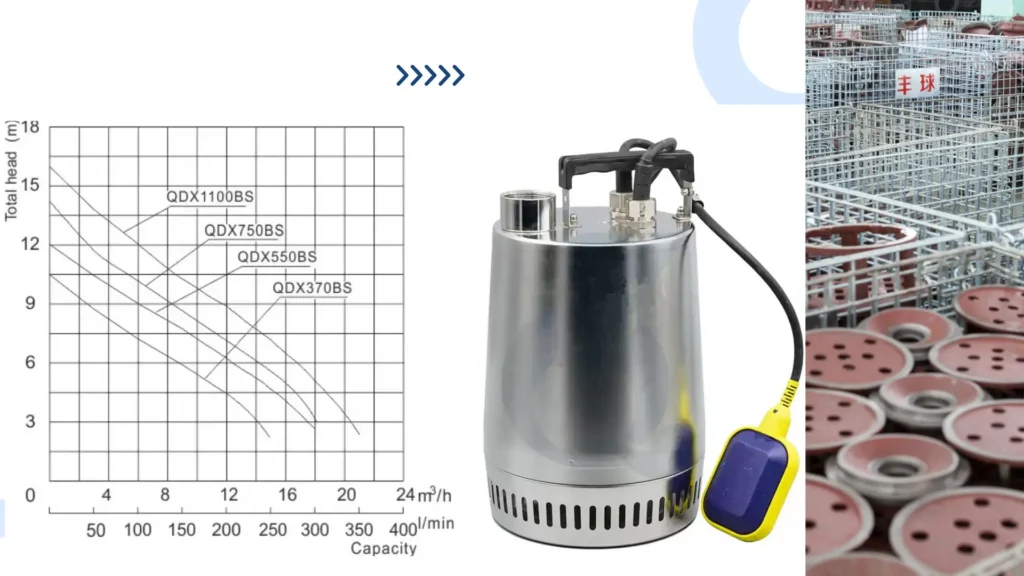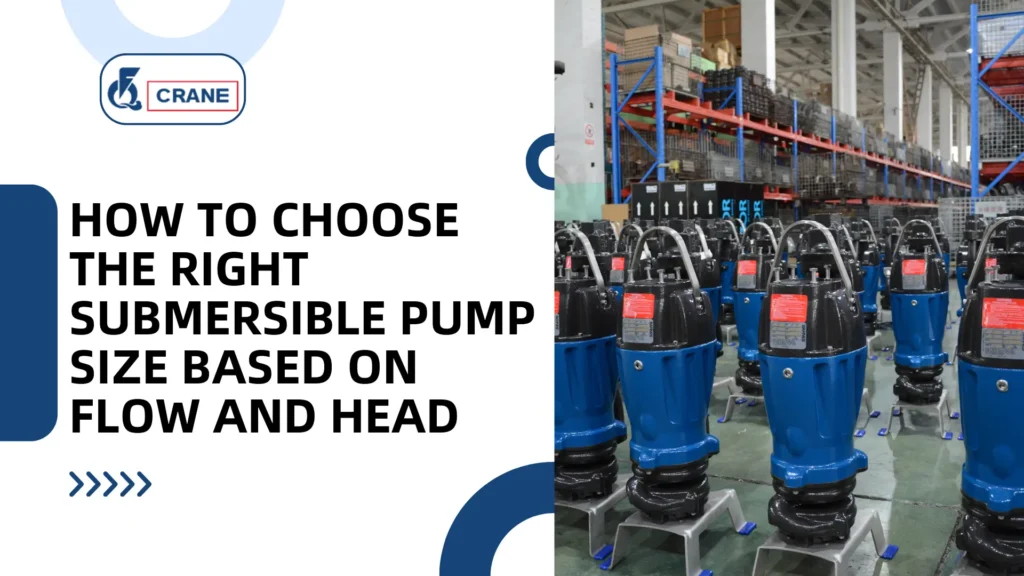Selecting the right submersible pump is crucial for efficiency and performance across various applications.
A well-chosen pump can save energy, reduce maintenance costs, and enhance overall productivity.
This guide aims to provide an accessible overview of how to determine the appropriate pump size based on flow rate and head requirements.
By understanding these key factors, you can make informed decisions that will lead to better outcomes in your pumping tasks.
And More:
- Choosing the Right Submersible Pump for Waterworks
- Design and Optimization of Efficient Flood Control Pump Systems
- Cost-Benefit Analysis of Submersible Pumps in Municipal Systems
Why is Flow Rate Important?
Understanding Flow Rate
Flow rate is defined as the volume of fluid a pump can move over a specified period, commonly measured in gallons per minute (GPM) or liters per second (L/s).
Understanding flow rate is essential for determining whether a pump can meet the demands of a given task, whether it’s draining water, supplying irrigation, or facilitating industrial processes.

Impact on Pump Selection
Selecting the correct flow rate is critical for ensuring that the pump effectively meets the needs of your application.
An undersized pump may struggle to keep up with demand, leading to inefficiencies, increased wear, and potential breakdowns.
Conversely, an oversized pump can lead to excessive energy consumption and increased operational costs, making it essential to find the right balance.
Calculating Your Required Flow Rate
To determine the necessary flow rate, consider the following factors:
The Size of the Area
Larger areas requiring drainage will necessitate higher flow rates to be drained effectively within a reasonable timeframe.
Frequency of Usage
If you anticipate frequent use, you will need a pump capable of sustaining a consistent flow without overheating or failing.
Assessing seasonal usage patterns can provide valuable insights into your flow requirements.
What is Head in Pumping Systems?
Definition of Head
In the context of pumping systems, “head” refers to the height to which a pump can raise water or other fluids.
It is measured in feet or meters and is a critical parameter for understanding a pump’s capabilities.
Head is influenced by various factors, including the vertical distance the fluid needs to travel and the resistance it encounters.
Types of Head
There are multiple types of head to consider when selecting a pump:
Static Head
This is the vertical distance between the water level and the discharge point when the pump is not operating. It sets the baseline for how high the pump needs to lift the water.

Dynamic Head
This refers to the additional height required when the pump is in operation, taking into account various factors such as friction losses and turbulence generated by fluid movement.
Total Head
Total head combines both static and dynamic head, providing a complete understanding of the pump’s lifting capacity under real-world conditions.
Importance of Total Dynamic Head (TDH)
Total Dynamic Head (TDH) is a critical measurement that encompasses all head components.
It gives a comprehensive view of how a pump will perform in actual conditions, helping you select a pump that can reliably meet the demands of your application.
Understanding TDH is vital for ensuring that the selected pump can handle the specific lifting requirements without straining or operating inefficiently.
How to Calculate Total Dynamic Head (TDH)?
Components of TDH
To calculate TDH accurately, you need to consider several components:
Static Lift
The vertical distance from the water source to the discharge point when the pump is not in operation. This sets the initial height the pump must overcome.
Friction Losses
These are losses incurred due to the flow of fluid through pipes, fittings, and valves.
Friction increases with longer pipe lengths and smaller diameters, directly impacting the pump’s efficiency.
Additional Head
Any extra head required due to accessories like filters, valves, or elbows in the piping system should also be included in your calculations.

Tools and Formulas
Calculating TDH can be simplified using basic formulas:
TDH=Static Lift+Friction Losses+Additional Head
Additionally, there are online calculators and software tools available that can assist you with these calculations, making it easier to determine the necessary specifications for your pumping system.
Common Mistakes to Avoid
When calculating TDH, it’s crucial to avoid common mistakes that could lead to inaccurate results.
Ensure you account for all components accurately, as underestimating friction losses or failing to include additional head requirements can result in selecting a pump that is inadequate for your needs.
Double-checking your calculations and consulting with manufacturers can help mitigate these risks.
How to Match Pump Size with Flow Rate?
Recommended Practices
To ensure optimal performance, focus on matching the pump’s flow rate with your calculated requirements.
This can help you avoid issues like pump cycling, where the pump frequently starts and stops, leading to wear and potential failure.
A pump that operates consistently within its designed flow rate range will generally last longer and perform better.
Using Manufacturer Guidelines
Consulting manufacturer specifications is invaluable when selecting a pump.
Most manufacturers provide flow rate charts correlating specific pump sizes with their capacities.
These charts can serve as a reliable reference, helping you make well-informed choices based on your specific application requirements.

Balancing Efficiency and Cost
Finding a balance between efficiency and cost is essential when selecting a pump.
While larger pumps may offer higher flow rates, they can also come with increased initial costs and higher energy expenses.
Consider both short-term and long-term operational costs alongside the initial investment to ensure you achieve the best overall value for your pumping system.
How Does Pipe Diameter Affect Performance?
Understanding Pipe Flow
The diameter of the pipe through which the fluid flows significantly influences flow rate and overall system performance.
Larger diameters allow for greater flow rates, which can be especially important in applications requiring high-volume fluid movement.
Conversely, smaller diameters can restrict flow and increase pressure losses.
Relationship Between Diameter and Pressure
A larger pipe diameter can reduce friction losses, leading to less energy being required to move the fluid. However, larger pipes may also incur higher installation costs.
It is essential to find a balance that meets your performance requirements without incurring unnecessary expenses.
Recommendations for Pipe Sizing
Using guidelines for pipe sizing is crucial to ensure that your pump and piping system work effectively together.
A common recommendation is to choose a pipe diameter that allows for sufficient flow without creating excessive pressure loss.
Consulting with engineers or using industry-standard charts can help in making these decisions.
What Role Does Fluid Type Play in Pump Selection?
Viscosity and Density Considerations
Different fluids exhibit varying viscosities and densities, which can significantly impact pump performance.
For example, thicker fluids require more power to move and may necessitate a more robust pump.
Understanding the characteristics of the fluid you plan to pump is essential for selecting an appropriate pump.

Compatibility with Materials
Ensure that the materials used in the pump are compatible with the fluid being pumped.
his consideration is crucial to prevent issues such as corrosion, wear, and potential failures.
Manufacturers often provide compatibility charts to help you choose the right materials for your specific application.
Special Considerations for Contaminated Fluids
When pumping contaminated or abrasive fluids, it’s essential to select pumps specifically designed for such applications.
These pumps often incorporate enhanced materials and protective measures, ensuring longevity and efficiency when dealing with harsh conditions.
How to Ensure Proper Installation and Maintenance?
Installation Best Practices
Following best practices during installation is crucial for maximizing pump performance and longevity.
This includes ensuring proper alignment, securing all connections, and adhering to the manufacturer’s guidelines.
A well-executed installation can prevent many common issues that arise from improper setup.
Regular Maintenance Checks
Implementing a regular maintenance schedule is vital for identifying and resolving issues early.
Simple tasks such as checking seals, cleaning filters, and monitoring performance can prevent costly repairs down the line.
Establishing a routine maintenance protocol can significantly extend the lifespan of your pump.
Troubleshooting Common Issues
Being aware of common problems, such as unusual noises or decreased performance, allows for quick troubleshooting.
Familiarizing yourself with the pump’s operating manual and understanding its typical performance characteristics can help you identify potential issues before they escalate.

Conclusion
Choosing the right submersible pump size based on flow rate and head is essential for achieving optimal performance.
By understanding key factors such as flow rate, head calculations, and proper installation practices, you can make informed decisions that meet your specific needs.
Investing time in this process will not only enhance the efficiency of your pumping system but will also save you time and money in the long run.
Properly selected and maintained, a submersible pump can deliver reliable service for years to come, ensuring that your fluid management tasks are executed smoothly and effectively.

